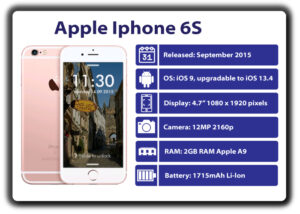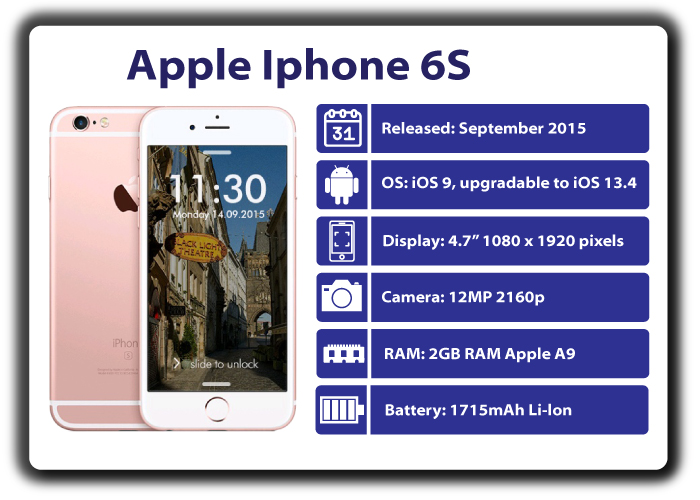
The iPhone 6s, released in 2015, continued Apple’s tradition of pushing technological boundaries and setting new standards in the smartphone industry. In this comprehensive overview, we’ll delve into key aspects of the iPhone 6s, covering its release details, operating system, display, camera capabilities, RAM, battery performance, and its price in USD.
Release: Apple introduced the iPhone 6s to the world on September 25, 2015, building on the success of its predecessor with a range of new features and improvements. The device garnered attention for its enhanced performance, innovative 3D Touch technology, and an upgraded camera system.
Operating System: At launch, the iPhone 6s ran on iOS 9, the ninth major release of Apple’s mobile operating system. iOS 9 brought forth various refinements, including improved Siri functionality, a more intelligent and proactive assistant, and enhancements to system performance and battery life.
Display: The iPhone 6s featured a 4.7-inch Retina HD display, maintaining the same screen size and resolution as its predecessor but introducing a crucial innovation – 3D Touch. This pressure-sensitive technology enabled users to interact with their devices in new ways, opening up a range of possibilities by detecting different levels of force applied to the screen. The display itself retained the excellent color accuracy and clarity that users had come to expect from Apple’s Retina displays.
Camera: One of the standout features of the iPhone 6s was its improved camera system. The rear-facing iSight camera received a resolution bump to 12 megapixels, enhancing the level of detail in photos. Additionally, the camera could now capture 4K video, providing users with the ability to record stunningly sharp footage. The front-facing FaceTime camera was upgraded to 5 megapixels, supporting Retina flash for better low-light selfies. Live Photos, a feature that captured a snippet of video alongside each photo, added a dynamic element to the overall photography experience.
RAM: The iPhone 6s was equipped with 2GB of RAM, doubling the amount found in the iPhone 6. This increase in memory allowed for smoother multitasking, improved app performance, and better overall responsiveness. The combination of the A9 chip and increased RAM made the iPhone 6s a capable device, capable of handling demanding tasks and running the latest apps with ease.
Battery: The iPhone 6s housed a non-removable 1715mAh lithium-ion battery. Despite a slightly smaller capacity than its predecessor, the efficiency improvements brought by the A9 chip and iOS 9 optimizations ensured that the device maintained respectable battery life. The introduction of Low Power Mode provided users with an additional tool to extend battery longevity during times of need.
Price (USD): The iPhone 6s was available at various price points depending on storage capacity and carrier agreements. The 16GB model was priced at approximately $649 without a contract, with prices increasing for higher storage configurations. Carrier subsidies and installment plans also influenced the overall cost of ownership.
In conclusion, the iPhone 6s marked a significant step forward in Apple’s relentless pursuit of innovation. With advancements in camera technology, the introduction of 3D Touch, and enhancements to performance and user experience, the iPhone 6s solidified its place as a flagship device in the ever-evolving landscape of smartphones.



1 Comment
Very excellent information can be found on blog.Raise blog range